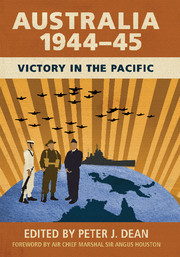Book contents
- Frontmatter
- Dedication
- Foreword
- Contents
- Maps and chart
- Figures and table
- Contributors
- Acknowledgements
- Abbreviations
- Military symbols on maps
- Introduction
- PART 1 STRATEGY
- PART 2 AUSTRALIA AT WAR
- PART 3 GREEN ARMOUR AND SPECIAL OPERATIONS
- 6 Learning and Adapting for Jungle Warfare, 1942–45: The Australian and British Indian Armies
- 7 Intelligence and Special Operations in the Southwest Pacific, 1942–45
- PART 4 THE NAVAL AND AIR WAR
- PART 5 THE NEW GUINEA CAMPAIGN
- PART 6 THE BORNEO CAMPAIGN
- Afterword: And Then Came Peace?
- Index
- References
6 - Learning and Adapting for Jungle Warfare, 1942–45: The Australian and British Indian Armies
from PART 3 - GREEN ARMOUR AND SPECIAL OPERATIONS
Published online by Cambridge University Press: 05 December 2015
- Frontmatter
- Dedication
- Foreword
- Contents
- Maps and chart
- Figures and table
- Contributors
- Acknowledgements
- Abbreviations
- Military symbols on maps
- Introduction
- PART 1 STRATEGY
- PART 2 AUSTRALIA AT WAR
- PART 3 GREEN ARMOUR AND SPECIAL OPERATIONS
- 6 Learning and Adapting for Jungle Warfare, 1942–45: The Australian and British Indian Armies
- 7 Intelligence and Special Operations in the Southwest Pacific, 1942–45
- PART 4 THE NAVAL AND AIR WAR
- PART 5 THE NEW GUINEA CAMPAIGN
- PART 6 THE BORNEO CAMPAIGN
- Afterword: And Then Came Peace?
- Index
- References
Summary
Defeats in the Malayan, Papuan and Burma campaigns of 1942 convinced the Australian and Indian armies that new tactics and training were required for new and challenging environments. In particular, it became apparent that basic training had been woefully inadequate for the rapidly expanded armies, many of whom lacked a clear understanding of basic tactics, techniques and procedures. There were various pre-war manuals available, including Field Service Regulations, as well as branch-specific manuals such as Infantry Training: Training and War; these were still relevant and, with updating during the war, served as foundational resources.
The key lessons from the defeats of 1942 were the need for proper basic training and specialised training in jungle warfare for all the new units and formations. The latter, however, could follow only after foundational or basic training had been reformed and jungle warfare doctrine had been formulated. As the Australian jungle warfare manual stated in 1943,
[I]t will be clear to all commanders that the information contained in this pamphlet will prove of little value unless the principles set out are closely studied and thorough training conducted in units and sub-units. It presupposes that special training in jungle warfare is necessary, and should follow the completion of normal basic training.
The British Indian Army Manual of 1943 stated similar sentiments:
[I]n principle there is nothing new in jungle warfare, but the environment of the jungle is new to many of our troops. Special training is therefore necessary to accustom them to jungle conditions and to teach them jungle methods.
Training in jungle warfare was not a ‘black art’, but it did require some specialised thinking and training to adapt to the unique environment, even for veteran formations such as the 9th Australian Division.
By the end of 1944, both the Australian and the British Indian armies had become fully capable not only of operating in the jungle environment, but also of conducting open terrain, amphibious and combined arms operations against the Imperial Japanese Army in the Southeast and Southwest Pacific Command regions. They had, as institutions, integrated the knowledge that ongoing learning and adaptation were integral to their achievements. This chapter will analyse how and why these reforms came about.
- Type
- Chapter
- Information
- Australia 1944–45Victory in the Pacific, pp. 121 - 144Publisher: Cambridge University PressPrint publication year: 2015



